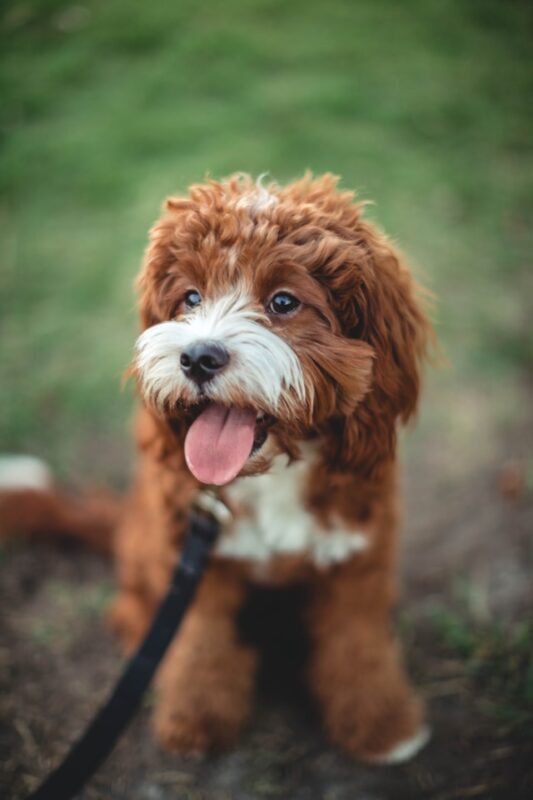What is a Cavapoo Dog?
Posted: 06/19/2024 | BY: Jenna Bruce | Categories: Dog , Health problems , Pet care
What is a Cavapoo dog? Also sometimes called a Cavoodle, this adorable fur baby is a cross between a Cavalier King Charles Spaniel and a Poodle. These pups look like living, breathing teddy bears with fluffy coats, round faces, and big, brown eyes that make you instantly fall madly in love.
Let’s take a deeper dive so we can learn all about these amazing little fluff balls.

Meet the Adorable Cavapoo
Cavapoos are the ultimate cuddle companions. These affectionate and loving dogs adore spending time with their families, whether it’s a movie night on the couch or playtime in the park. Snuggling a Cavapoo is like embracing a living teddy bear, with their soft fur and gentle nature.
Beyond their charming looks, Cavapoos are known for being well-behaved and easy to train. Their eagerness to please and playful spirit make them a joy to train using positive reinforcement methods.
Cavapoos also boast qualities that make them perfect for various lifestyles. Their low-shedding coat makes them a good choice for allergy sufferers, and their smaller size allows them to thrive in apartments.
If you’re looking for a loving, affectionate, and cuddly dog that fits your lifestyle, a Cavapoo might just be your perfect furry match.
Having said that, Cavapoos are prone to certain health issues that both of their parents genetically face. Before bringing one into your life and home, it’s important to understand what health issues they may face as they age so you can be prepared.
Let’s take a look at the most common Cavapoo health issues.
Most Common Cavapoo Health Issues
Both purebred and mixed breed (designer) dogs can inherit health conditions from their parents, and Cavapoos are no exception. This means that Cavapoos can inherit health conditions that are common with Poodles and Cavalier King Charles Spaniels. This is why it is so important to buy from a reputable breeder who screens for dogs genetic health conditions.
Now let’s take a look at some of the most common health conditions this designer dog is known for:

Entropion
Entropion is a condition where a dog’s eyelid, usually the lower one, rolls inward. This causes the eyelashes and other hair to rub painfully against the cornea, the eye’s clear surface.
This inward fold is an inherited trait in some breeds and can be quite serious. The constant irritation leads to inflammation, ulcers, and scarring on the cornea. This can permanently damage vision and, in severe cases, require removal of the eyeball (enucleation).
Entropion is often treated with surgery to correct the lid deformity. The procedure can cost around $500 if performed by a general practitioner and up to $1500 if done by a licensed veterinary ophthalmologist.
Patellar Luxation
Patellar luxation is a common problem for small dogs, affecting their knees. The kneecap, called the patella, normally sits in a groove in the thigh bone. With luxation, the patella slips out of this groove, either occasionally or permanently.
Imagine your own kneecap moving to the side of your knee. This wouldn’t be painful initially, but the misaligned joint would feel unstable. In dogs with patellar luxation, this instability makes it difficult to stand or walk properly.
Left untreated, patellar luxation can lead to arthritis and even more serious knee problems. It typically affects both hind legs, although one leg might be more noticeably impacted than the other.
There are two main approaches to treating patellar luxation in dogs, depending on the severity:
- Non-surgical management: This is suitable for mild cases (Grade I or II) where the kneecap luxates occasionally. It focuses on pain relief and preventing future problems. This might include:
- Medications: Pain relievers can help manage discomfort once arthritis sets in.
- Supplements: Glucosamine and other joint supplements can be given even before arthritis develops to support joint health.
- Weight management: Keeping your dog at a healthy weight is crucial. Less weight on the joints means less wear and tear, slowing down arthritis.
- Surgery: This is recommended for severely affected dogs (Grade III or IV) where the kneecap frequently pops out of place. However, surgery can also be beneficial for some dogs with less severe cases. Surgery can cost between $1,500 and $3,000 per affected knee. While that may seem quite expensive, long-term medications for pain can also be expensive!
Mitral Valve Disease (Endocardiosis)
Endocardiosis, the most common heart disease in dogs (75% of cases), affects the heart’s valves. It primarily strikes the mitral valve (between the left atrium and ventricle), causing it to leak (mitral valve insufficiency). This leakage forces the heart to work harder, leading to various health problems.
The disease mainly affects older, small breed dogs, with a slight male predominance. The cause is unknown, but genetics likely play a role.
Fortunately, many dogs with mitral valve disease don’t need treatment until they show symptoms. When medication is necessary, drugs effectively manage the condition for most pets, allowing them to live happy lives.
Medications are typically used to address the symptoms:
Diuretics: Help remove excess fluid buildup.
Beta-blockers: Lower blood pressure in the heart.
Other heart failure medications: Address various symptoms like coughing or fatigue.
While open-heart surgery to replace valves has been attempted, it’s considered too risky at present. So, medication, along with a low-sodium diet and exercise restrictions, remain the primary treatment options.
Cataracts
Cataracts are cloudy areas that form on the lens of an eye, clouding vision. Just like us, dogs and cats rely on their lenses to focus light and see clearly.
These cloudinesses can develop for various reasons, including:
- Age (most common)
- Genetics (in dogs)
- Injuries
- Diabetes (in dogs)
- Nutritional deficiencies
If a cataract isn’t too big, a pet may still have some vision. However, cataracts often affect both eyes and can worsen over time.
Besides vision loss, cataracts can lead to other eye problems like:
- Lens dislocation
- Inflammation
- Glaucoma
If you notice your pet bumping into things or having trouble seeing, it’s important to visit a veterinarian for a diagnosis and treatment plan.
The most common treatment for cataracts is surgery to remove the cloudy lens. Traditionally, surgeons made an incision to remove the lens. Now, a less invasive technique called phacoemulsification is preferred. This method uses sound waves to break up the lens, which is then suctioned out.
An artificial lens is usually implanted after surgery. Without it, your pet won’t be able to focus clearly. Surgery costs between $1,500 and $5,000 per eye.

Can Pet Insurance Help Pay for These Health Issues?
While pet insurance won’t cover pre-existing conditions, it can help manage the costs of treating many common Cavapoo health issues. It’s important to carefully review plan details and exclusions before enrolling, as coverage can vary depending on the company and your pet’s health history.
Final Thoughts
What is a Cavapoo dog? It’s one of the most adorable things you’ve ever seen. If you like the idea of having a joyful, playful, and gentle companion that looks like a living teddy bear, then a Cavapoo may be the ideal pup for you.
References:
- https://dogtime.com/dog-breeds/cavapoo
- https://www.petmd.com/dog/breeds/cavapoo
- https://www.thesprucepets.com/cavapoo-full-profile-history-and-care-5079745
Disclaimer
The information contained on this blog is intended for informational and educational purposes only and should not be construed as medical advice. It is not a substitute for professional veterinary care. Always consult with your veterinarian before making any changes to your pet's health care or treatment plan.
The authors of this blog are not veterinarians and do not claim to be experts in pet health. The information provided here is based on our own experiences and research, as well as information from reputable sources. However, we cannot guarantee the accuracy or completeness of this information.
We encourage you to do your own research and consult with your veterinarian before making any decisions about your pet's health.
Previous post
How to Check for Ticks on Your DogNext post
Help with Vet Bills: 7 Pawsome IdeasCompare top pet insurance providers & plans.
Enter your dog’s age in years and months to calculate their age equivalent to human years.
Calculate your dog’s ageEnter your cat’s age in years and months to calculate their age equivalent to human years.
Calculate your cat’s age
